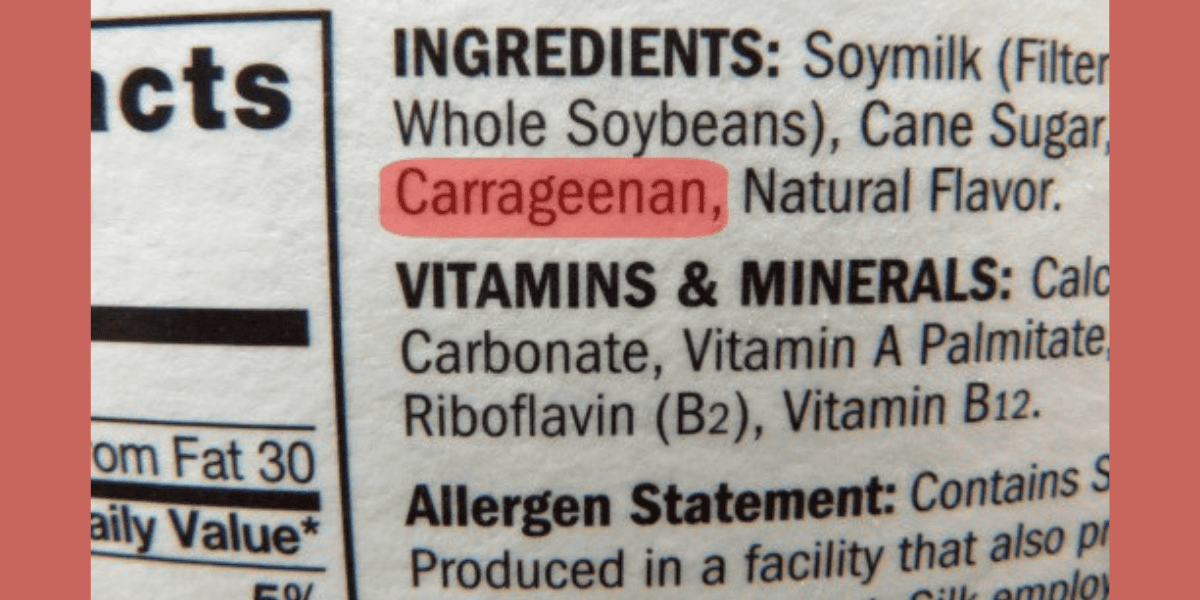EDITOR’S SUMMARY: You’ve cultivated a watchful eye on the food you eat. You understand that clever marketing on Big Food products is big business, so you cautiously pay close attention. But when you can’t see hidden additives or agents because they’re sprayed on produce, neatly tucked away in premade dishes, or a different name is used on packages to conceal the original, as may be the case with carrageenan, “out of sight, out of mind” may have dangerous consequences.
By Carter Trent
In addition to sourcing food for your family and yourself, if you’ve decided to take on an “eat healthier” mission, your trip to the grocery store may involve navigating a maze of mysterious ingredients, some of which could be harmful to your health. One of these substances is carrageenan. It’s among the 10,000 chemicals and additives allowed in the United States food supply by the U.S. Food and Drug Administration (FDA), which oversees (or doesn’t) the safety of these products. Carrageenan is added to all kinds of foods, including but not limited to non-dairy milks, kefir, ice cream, yogurts, deli meats, frozen pizzas, and organic cuisine. Eating at restaurants can expose you to the additive as well. For instance, the substance may be in your salad’s ranch dressing, or in a variety of sauces. Here are some foods that commonly contain carrageenan:
- Coconut, soy, almond, and hemp milks
- Protein shakes and powders
- Yogurt
- Cottage cheese
- Chocolate milk
- Beer, wine, and juice
- Deli meats
- Canned soups and broth
- Creamy sauces such as ranch and Caesar salad dressings, mayonnaise, and gravies
- Ice cream
- Packaged, ready-to-eat meals, including frozen burritos and pizza
- Infant formula in the U.S.
Yet the European Food Safety Authority (EFSA), the FDA’s counterpart in Europe, banned carrageenan in infant formula. Curiously, the EFSA deemed it safe to use in all other food. In the U.S., the FDA assigned it the designation “generally recognized as safe,” or GRAS for short. This means carrageenan is considered safe to use in all food. The FDA does not restrict its use in baby formula. Why is carrageenan considered safe if the EFSA marked it dangerous for infants? Solving this equation requires putting on a detective’s hat, digging into the background, and unraveling the complexities behind how its consumption might affect you.Carrageenan is a soluble fiber extracted from red seaweed. It possesses gel-forming properties, and this trait has made it popular in cooking for centuries. The seaweed containing carrageenan is known as Irish moss because it rose to prominence in Ireland. It’s been used to thicken, emulsify, and preserve foods and drinks, including Irish pudding and beer. Carrageenan’s name is said to come from the Irish word carraigín, which means “little rock,” and describes a cape in Northern Ireland called Carrigan Head.
In today’s industrialized food supply, carrageenan was adopted as an additive during World War II, after the supply of agar-agar, another seaweed thickener sourced from Japan, was no longer available. Carrageenan is so versatile, it is applied to food products for a variety of purposes. Manufacturers utilize it as an emulsifier and thickening agent, similar to how it’s been used in Ireland. It’s also employed as a stabilizer, which maintains or improves the consistency, look, and shelf life of food. It provides a creamy texture to ice cream, pudding, and condensed milk. It’s also an encapsulation tool in food. This means carrageenan encloses, or encapsulates ingredients that food manufacturers want to protect throughout the manufacturing process, and while the product sits on a shelf, waiting to be consumed.
For example, carrageenan encapsulates probiotics found in certain yogurts. Because they are living microorganisms, encapsulation is intended to preserve them. Another reason for carrageenan’s widespread use as an additive is its compatibility with vegan diets. Manufacturers use it in foods targeted toward vegetarian and vegan consumers, like dairy beverage substitutes. Carrageenan is added to nutritional supplements as well, including chewable vitamins to provide a sought after texture. Because of its many uses, the additive is applied to products beyond food too. It’s found in toothpaste, sunscreen, lotion, facial scrub, and shampoo. Note that carrageenan may be listed as “Chondrus crispus,” the scientific name for Irish moss, also known as sea moss.
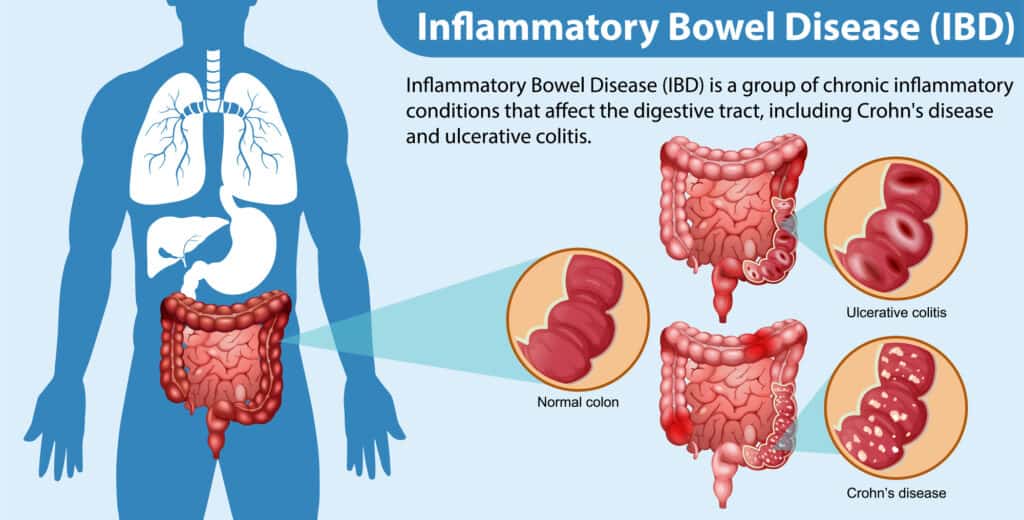
Unraveling the Mystery of Carrageenan’s Safety
The FDA designated carrageenan safe as a food additive in 1961. But its safety has been in debate over the ensuing decades. Inquiry of whether carrageenan was safe kicked into high gear in 1983. That’s the year the International Agency for Research on Cancer (IARC) classified degraded carrageenan as a cancer risk to humans. The IARC’s determination came about after several research studies found that rats who were fed degraded carrageenan developed colorectal cancer. It’s important to note that carrageenan and degraded carrageenan are not the same substance. Degraded carrageenan, officially known as poligeenan, is formed from carrageenan that has been exposed to high temperatures and acid hydrolysis. This is a method that breaks down food with water and various acids, such as sulphuric and hydrochloric acid. Poligeenan is created and used in industrial processes unrelated to food. For example, it’s utilized in pharmaceutical research. Animals in laboratories are given poligeenan to cause inflammation in order to test the effectiveness of new anti-inflammatory drugs. Poligeenan is not approved as a food additive, and is universally recognized as unsafe to eat.
The realization that carrageenan in the form of poligeenan could cause cancer helped to spur research into both substances. According to a 2001 study published in the scientific journal Environmental Health Perspectives, carrageenan harm your digestive tract by acting as a contributor to inflammatory bowel diseases (IBD), such as Crohn’s disease and ulcerative colitis. The study, “Review of Harmful Gastrointestinal Effects of Carrageenan in Animal Experiments,” stated:
“Inflammatory bowel disease and colorectal malignancy represent major sources of morbidity and mortality in the United States. A possible factor in the etiology of these pathologies is exposure to carrageenan.”
The study identified carrageenan as a potential contributor to inflammatory bowel diseases because carrageenan could be transformed into poligeenan as a result of your body’s digestive processes and gut bacteria.
“This association may be attributed to contamination of undegraded carrageenan by components of low molecular weight, spontaneous metabolism of undegraded carrageenan by acid hydrolysis under conditions of normal digestion, or the interactions with intestinal bacteria.”
This helps explain why, as carrageenan’s use as a food additive has expanded over time, the incidence of IBD has grown as well. Global cases of IBD grew from 3.7 million in 1990 to over 6.8 million in 2017. However, other scientific studies disputed the theory that your body transforms carrageenan to poligeenan, stating the temperature required to do so is far higher than is possible in the human body. In a laboratory setting, poligeenan is produced after exposing carrageenan to temperatures greater than 175 degrees Fahrenheit for several hours, far exceeding the human body’s normal temperature of 98.6 degrees. Moreover, studies measuring the amount of carrageenan excreted by the human body identified that 98% to 100% was expelled from the body intact, meaning it was not converted to poligeenan.
A 2017 paper, published in the scientific journal Frontiers in Pediatrics, reviewed multiple studies on the effects of carrageenan on animals, and confirmed the substance played a role in intestinal problems. “The Role of Carrageenan and Carboxymethylcellulose in the Development of Intestinal Inflammation,” concluded:
“Taken together, these animal studies have led to the hypothesis that food emulsifiers such as carrageenan may act as a conditional inflammatory agent that magnifies any existing chronic inflammation of the intestinal tract provoked by pathogens. This hypothesis explains why carrageenan has been found to induce intestinal inflammation in most animal studies, but not all.”
More recently, a 2024 study conducted by BCM Medicine (BioMed Central), “Carrageenan and insulin resistance in humans: a randomised double-blind cross-over trial,” also concluded that carrageenan may cause damage to the lining of the small intestine leading to Crohn’s disease. Additionally, they found it inhibits your body’s ability to process blood sugar (insulin resistance), which can lead to type 2 diabetes and cardiovascular disease. In other words, whether you have a pre-existing health problem in your gut or not, carrageenan has the potential to create one.
So how does carrageenan create this inflammatory condition if poligeenan is the substance that causes inflammation, yet is not legally permitted in food? Groups such as the Cornucopia Institute, a watchdog organization for the organics industry, pointed to carrageenan’s manufacturing process as the culprit. The industrial production of carrageenan requires extracting it from red seaweed, which results in altering its chemistry. A widely-used method to do this extraction is to boil the seaweed in an acidic solution, the very conditions contributing to the creation of poligeenan. The acids used include sulfuric, phosphoric, hydrochloric, and nitric. The seaweed is bathed in this water and acid solution to break the seaweed’s cell walls and free the carrageenan. Then the solution is drained away, and the carrageenan washed and dried for use in food. This chemical process is preferred by manufacturers because it is efficient at separating carrageenan from the seaweed.
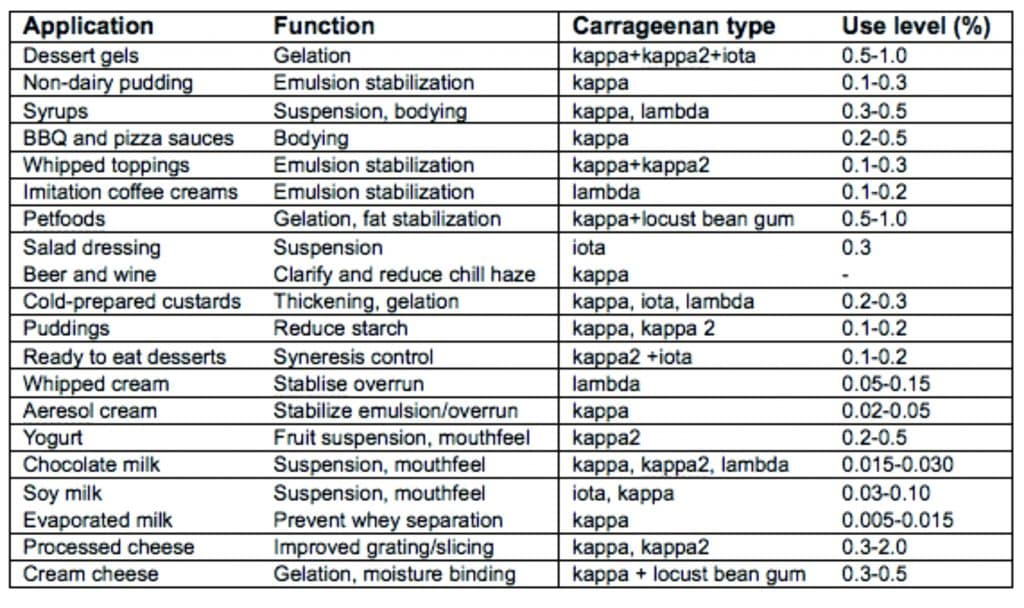
Different grades of the substance are manufactured depending on its intended use, and the specific sub-species of seaweed. The three primary species of Irish moss adopted for manufacturing purposes are called iota, kappa, and lambda. Iota is selected to create elastic gels, while kappa forms rigid gels. Lambda is chosen when no gel formation is needed. When carrageenan was first introduced into mass production, an expensive, difficult process was used to make it. This process is still employed today to produce what’s called refined or filtered carrageenan. Due to the high cost to make it, it’s no longer added to food, but rather, it’s used for medicine. A cheaper, more common method of carrageenan production, applying the acid hydrolysis method described above produces what’s called semi-refined carrageenan, and is frequently used in pet food. A more recent, less expensive acid hydrolysis production method, named Philippine natural grade, adds bleach to the process to reduce the bacterial count in the moss. The carrageenan from this method is widely used in human food. The Cornucopia Institute weighs in on carrageenan’s manufacturing processes:
“The alkaline treatments create chemical changes in the algal extracts that maximize benefits to food manufacturers. None of the most common food-grade carrageenan is created by naturally occurring biological processes or rudimentary processes that can be done in a home kitchen.”
A study published by Marinalg International, a lobby group supporting carrageenan manufacturers, bolsters the Cornucopia Institute’s position that the manufacturing process causes the inadvertent creation of poligeenan. This study showed samples of carrageenan tested positive for poligeenan. There’s no way to know if the carrageenan in your food contains traces of poligeenan unless you were to commission a laboratory to test it. Linley Dixon, PhD, the Cornucopia Institute’s senior staff scientist, stated:
“Now, the industry’s own data has revealed that all twelve food-grade carrageenan samples tested did in fact contain poligeenan in varying quantities up to 25%.”
These kinds of concerns resulted in another twist in the carrageenan controversy. In 2016, the National Organic Standards Board (NOSB) recommended the U.S. ban carrageenan from organic food, especially since viable alternatives were available, such as gellan gum and xanthan gum. The NOSB is an advisory committee to the U.S. National Organic Program, which is administered by the U.S. Department of Agriculture (USDA). The NOSB helps the USDA come up with rules to govern the organics industry. Despite the NOSB’s recommendation, the USDA refused to ban carrageenan. To this day, carrageenan is allowed as an additive in organic food. The next time the USDA will reconsider this decision is May 2028. These controversies are why a 2018 paper, “Revisiting the carrageenan controversy: do we really understand the digestive fate and safety of carrageenan in our foods?” published in the Food & Function journal, called for more research to fill in the gaps in scientific knowledge of carrageenan’s effects on your body. The paper’s authors stated:
“Altogether, revisiting the scientific evidence indicates that more research is needed to elucidate the possibility that continued exposure to increasing levels of carrageenan in the human diet may compromise human health and well-being.”
The article called out three key gaps in the scientific understanding of carrageenan’s health risks. The first is that there’s no insight into how much carrageenan you’re consuming. Second, there’s a lack of understanding around how carrageenan interacts with the gut microbiome, and how the digestive process breaking down carrageenan affects your body. Lastly, there’s little knowledge of carrageenan’s impact on vulnerable members of the population, such as the elderly, infants, and those with inflammatory bowel diseases. It’s this last point, in particular, that resulted in the European Food Safety Authority’s decision to ban carrageenan from infant food. The EFSA revisited the matter in 2018, and concluded:
“In the absence of any further information on possible absorption of carrageenan by the immature gut in the very young infant, the Committee reaffirms its earlier view that it remains inadvisable to use carrageenan in infant formulae that are fed from birth, including those in the category of foods for special medical purposes.”
Even so, the EFSA didn’t ban carrageenan from other foods. With doubts around its safety still lingering, researchers continue to investigate the substance. A 2023 review of multiple carrageenan studies, published in the scientific journal Critical Reviews in Toxicology, reached a conclusion that mirrors earlier papers. Simply put, this article noted the ambiguity around the safety of carrageenan, and claimed there was enough research to suggest it could cause health issues in your intestines:
“Of the two food additives investigated in this scoping review, carrageenan appears to be the one for which further research is most urgently needed… degraded carrageenan appears clearly adverse in experimental animals, causing colitis and possibly cancer, and likely may do so also in humans, depending on the actual exposure (administration route, matrix and dose). The role of native, non-degraded carrageenan is less clear, however, a substantial number of publications reported adverse effects on the intestines also of this form of carrageenan in experimental animals, supported by plausible mechanistic data from in vitro studies.”
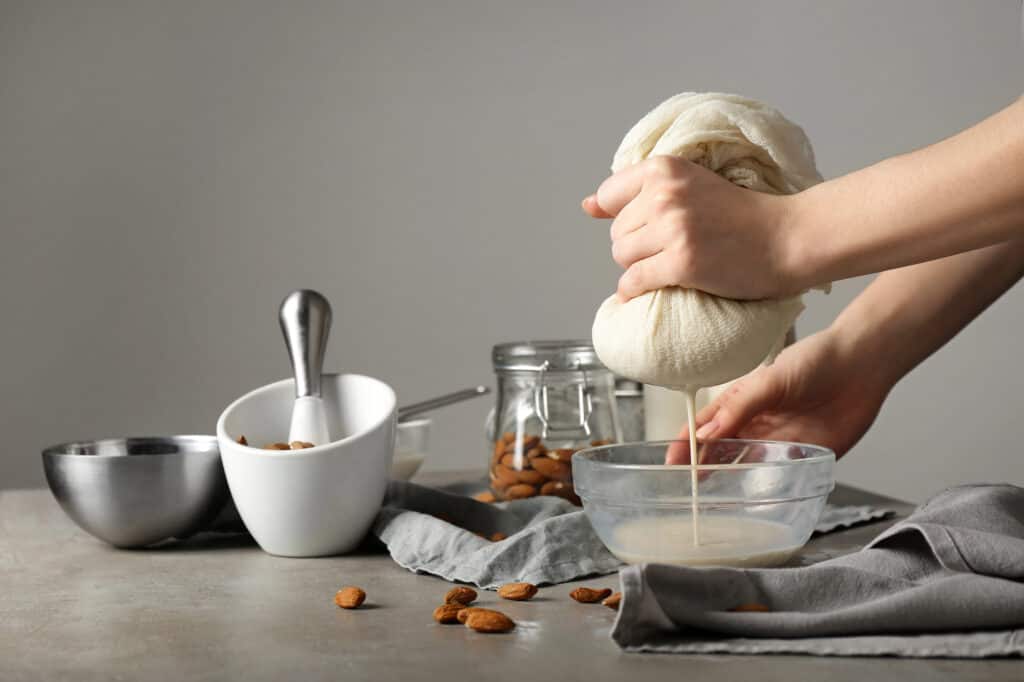
The Conclusion
As you can see from this investigation, conflicting opinions exist on how safe the additive is. Some groups feel it’s dangerous. Government organizations believe there’s not enough evidence to completely ban it, even in organic food. Given the mixed messages, limiting your exposure to carrageenan likely makes sense. According to Chris Kresser, functional medicine clinician and educator:
“Personally, I adhere to the “precautionary principle” for anything I eat; in other words, in the absence of proven safety, I choose to avoid foods that have questionable adverse effects. Carrageenan fits this description, as there’s still some doubt about its safety and no evidence has convinced me that there isn’t a potential for harm if consumed regularly.”
Although carrageenan is in many foods, you can choose whether you want to take the risk, or to what degree you’re comfortable with ingesting it. One way to limit your carrageenan intake is to read the ingredients list in the food you buy to confirm it doesn’t contain the additive. If it does, look for an alternative. For example, some brands of almond milk contain carrageenan but others do not; the same can be said of yogurts and protein powders, etc. To that end, the Cornucopia Institute published a guide to help you avoid carrageenan in organic food. This guide identifies brands that include or exclude the substance, so you can make informed decisions. To point out just a few products, the guide noted carrageenan in organic soy milk at Starbucks, organic cottage cheese from Clover Sonoma, organic corn and flour tortillas from Mission Organics, and organic almond pudding from Zen.
Even if you are careful with your grocery store choices, carrageenan is difficult to avoid completely. In fact, it’s sprayed on produce and cut fruit, including those designated organic, as a preservative to inhibit browning, and on meats to retain moisture. In these cases, the FDA does not require the additive to be listed on the ingredients label because it’s deemed a processing aid. From HortScience, “Guidelines and Acceptable Postharvest Practices for Organically Grown Produce”:
“For fresh-cut fruit, citric acid and ascorbic acid may be used as pH adjusters and/or antibrowning agents; calcium chloride or calcium citrate as firming agents, and carrageenan, xanthan gum, and water-extracted gums (Arabic, guar, locust bean, carob bean) as coating materials.”
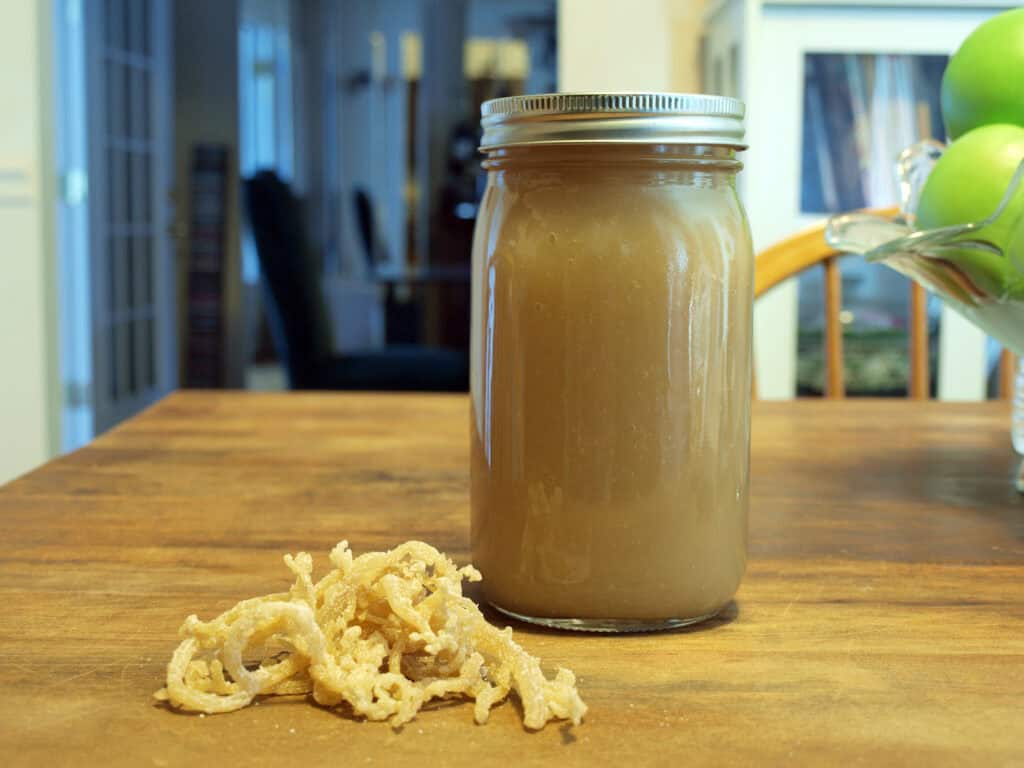
A practical approach to this problem is to limit exposure where you can, and manage potential stress should it arise, from worries about consuming carrageenan knowingly or inadvertently. After all, with more than 10,000 chemicals and additives in your food supply, it’s likely impractical to completely avoid them. If you love, love, love almond milk (or any other nut or seed milk), and can’t seem to find it without carrageenan or other additives, consider making it at home.
At the same time, consuming Irish moss in its natural state, and not its manufactured-ravaged offspring carrageenan, can promote health benefits. This sea moss contains taurine, an amino acid your body uses to build muscle. It can reduce your risk for heart disease as well. It provides iodine, which contributes to a healthy thyroid. It aids your gut health since it’s a good source of fiber and beneficial bacteria. You can make Irish moss into a gel, and use it as a thickening agent to replace cornstarch. You can make a tea from it, use it as a food topping, or eat it plain. The versatility and nutrients provided by Irish moss deliver a silver lining to the murky menace of carrageenan.
~
Published on October 31, 2024.
If you’ve found value in this article, please share it!
To support the research and health education of AVFC editorial, please consider making a donation today. Thank you.

